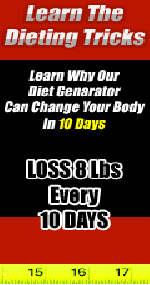Weight loss tips – How to lose 15 pounds in less than 3 months
January 29, 2017 by admin
Filed under Weight Loss Tips
Everybody knows that in order to lose weight you need to burn more calories than you consume by following a balanced diet and doing regular exercise. This is the abstract definition of weight loss. In this post I will explain step by step what you need to do if you want to lose 15 pounds of fat in 3 months or less.
Step 1: What is the effort to lose 15 pounds?
15 pounds of fat is equivalent to 52,500 calories. The first step is to understand the effort you have to put in order to lose 15 pounds. One pound of fat is approx. 3500 calories. This means that in order to reduce your weight by one pound you need to save 3500 calories. Based on this formula you can easily calculate how long it will take you to lose 15 pounds
For example:
To lose 15 pounds in 4 months: you need to save 13125 kcals per month or 3281 kcal per week or 468 kcal per day.
To lose 15 pounds in 3 months: you need to save 17500 kcals per month or 4375 per week or 625 calories per day.
To lose 15 pounds in 2 months: you need to save 26250 kcals per month or 6562 per week or 937 calories per day.
To lose 15 pounds in 1 month: You don’t even have to do the calculation because this is not going to happen. For starters it is not healthy (the recommended amount of pounds to lose per week is 1-to 2 pounds) and second it is impossible (or at least not possible for the majority of people).
Hint: You can try different combinations to calculate how long it will take you to lose weight by using our daily calorie calculator.
So, now that you know what it takes to lose 15 pounds the next step is to find the most appropriate way to do it. Before getting into the details though, you need to understand the difference between weight loss and fat loss
Step 2: Â How to lose fat and weight
Weight Loss Vs Fat Loss …
We will cover in detail the difference between fat loss and weight loss in a new post but for the purpose of this guide you need to understand that when you are losing weight you are not necessarily losing fat. At the beginning of a weight loss process you will lose water weight and this is in many cases misleading. The scale will show that you lost weight but in reality what makes you lighter is the loss of water weight only. In order to lose fat you need to force your body to convert fat from the fat stores to energy. By eating lesser calories than what you need per day you are telling your body to look for alternative sources of energy and as a result you start losing fat. What you need to take from this section is that in order to lose fat you have to create a calorie deficit by following a balanced diet and doing regular exercise as we are going to explain below.
Step 3: Â Lose pounds by consuming less calories per day
There are many ways to lose weight by consuming fewer calories per day. The trick here is to avoid very restrictive diets but ensure that you are eating the right foods in the right quantities. If you are following a commercial diet or weight loss program then you must stay away from crash diets and select a diet (or program) that is balanced and spread over a reasonable amount of time. Very low calorie diets (or very low fat diets) do not work in the long term and should be avoided. The best weight loss diet is one that can generate permanent results in a healthy way. You can also read about low GI diets and carb cycling which are 2 very good and healthy diet options.
If on the other hand you don’t want to follow a formal diet you can create your own diet plan and eating pattern based on the following principles:
1. Portion size does matter
There are many ways to control the size of your meals but taking the simplest approach is always the best. Since you are trying to lose weight, you can just divide your existing meal portions in half and save many calories. The change does not necessarily need to happen from one day to the next but you can gradually reduce your meal portions until you reach the desired size.
2. Eat Slowly
It’s a fact that people who eat fast they eat more. The brain needs around 15 minutes to get notified by the stomach about fullness and by eating fast you provide your body with extra (and unneeded) calories that will end up in the fat reserves. So it’s better to eat your food in a slow pace, chewing and enjoying every bite.
3. Frequent meals
I am sure you heard this before; eating frequent meals throughout the day has a number of benefits. First you aid digestion since it is easier for the stomach to digest smaller quantities of food. Second it keeps your stomach busy for longer periods, reduces hunger and as a result you avoid over calorie consumption with your main meals. Third it can improve your metabolism, meaning that the rate which your body burns calories is increased.
4. Water
Water plays a very important role in a healthy diet. For starters it has zero calories so drink as much as you want without worrying about adding to your weight. In addition it helps the digestion process and promotes detoxification (getting rid of unnecessary toxins from your circulation system). The recommended daily intake of water is 3.7 liters for men and 2.7 liters for women. Whenever you feel hungry drink a glass of water first and wait for 15-20 minutes. In many cases hunger will go away and you will save many calories. (see also Water for weight loss)
5. Avoid alcohol and soft drinks
If you want to lose weight fast then you need to avoid or reduce the consumption of alcoholic drinks as well as sugar full soft drinks. Alcohol and soft drinks do carry calories and sometimes people forget about it and destroy their diets without knowing why. There are many diet friendly drinks to choose from and at the same time satisfy your desire for a drink.
6. Cooking methods
It’s not only the ingredients of foods that carry calories but also the way you cook food. As a general rule of thumb avoid fried foods but instead go for baked or grilled. When cooking use olive oil instead of butter and other low fat products instead of full fat.
7. Fruits and vegetables
The dietary guideline for the Americans recommends 5 servings of vegetables per day. Fruits and vegetables are synonyms of a healthy diet and should not be missing from your meals. There are many choices that can satisfy every need and taste and they can be taken for breakfast, lunch, snack or dinner. Eating fruits and vegetables on a daily basis is a habit you can get used if you try it for a couple of weeks. Once you ‘teach’ your stomach and brain to eat fruits everything else will be easier.
8. Keep a diet journal
Keeping track of what you eat and drink throughout a day will make it easier to pinpoint mistakes in your diet and identify why you are consuming more calories than you need. I am not suggesting to become obsessed about calorie counting but having a clear picture of your daily calorie intake is useful especially if you decide to seek professional help. There are many online tools to help you record anything you eat or drink and do all the calculations for you; why not use our own online calorie counter, it’s free and accessible by all devices.
9. Go low fat and low calorie
Many products are labeled as low fat but if you carefully examine the food label they are not low in calories. The best diet friendly foods are those who are both low in fat and low in calories. Learn how to identify healthy fats and include those foods in your daily diet while avoid the consumption of full fat and high calorie foods.
10. Be proactive when it comes to your diet
Do not wait to get hungry and then think what to eat. It is much better to plan your meals in advance so that you have full control of what types of food to eat and in what quantities. Use a calorie counter to plan your balanced meals and prepare them in advance. Protect yourself by removing temptations (sweets, candies, potato chips, alcohol etc.) from your kitchen cupboards and do whatever it takes to stick to your plan.
Hint: You can also read our 50 Tips for Weight loss for even more healthy ideas.
Step 4: Â Lose pounds by exercising more
Dieting is only the half part of a weight loss equation; the other part is exercise and physical activity. Dieting can help you eat less calories but the only way to burn calories and keep the weight off in the long term is exercise. There are many forms of exercises which you can follow (cardio exercises, running on the treadmill, swimming, aerobics etc.) but one of the most effective forms of exercise for faster results is HIIT or High Intensity Interval Training.
High Intensity Interval Training for Weight Loss ..
HIIT is a technique to use while you work out. What this technique suggests is to alternate between high to low and moderate training periods in a single work out. This method keeps your body moving for the entire workout and as a result your heart rate is consistently at high levels and thus burning more calories. HIIT is suitable for people who want to lose a lot of pounds because fat burning is continued after the workout, in other words your Resting Metabolic Rate (RMR) is increased as you burn calories even when at rest.
HIIT can be used with both cardio type exercises and weight lifting. What is important is to follow the basic concepts i.e. alternate high with low training periods and do this consistently for 2-3 times per week.
Sample Workout schedule
The schedule below was compiled with the help of our personal trainers. Basically is a sample weekly workout based on the principles of HIIT (for Monday and Friday and normal cardio training for Tuesday and Thursday). Remember that before engaging into any intense exercise program you have to get the opinion of your doctor.
Monday and Friday – Â HIIT
Warm up for 5 minutes (walking)
After warm up walk for 40 seconds and then run for 20 seconds. Repeat 15-20 times (workout time 15-20 minutes)
Stretch for 2-3 minutes
Tuesday and Thursday –Normal Cardio Exercises
Wednesday – Free day
How to lose 15 pounds in 3 months or less. — summary
When you want to lose a considerable amount of pounds the best way to approach the process is like a big project – with start and finish dates, milestones, risks and assumptions. Create a plan by doing some basic calculations as explained above and stick to it until the end. If you encounter difficulties or if something does not go according to plan then do not get discouraged, change and refine the plan and continue until you are satisfied. Think positive and look forward for the finish date without worrying about short term delays.





